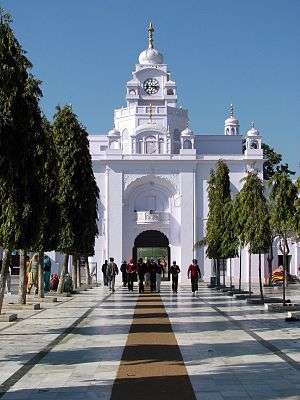Fateh Singh (Sikhism)
Sahibzada Fateh Singh Ji (12 December 1699 – 26 December 1704) was the fourth and youngest son of Guru Gobind Singh. He and his older brother, Sahibzada Zorawar Singh are among the most hallowed martyrs in Sikhism. He is also known as Baba Fateh Singh. The term Baba is used in India for an elder who is respected for his wisdom.
Sahibzada Fateh Singh | |
|---|---|
| Personal | |
| Born | 12 December 1699 |
| Died | 26 December 1704 (aged 5) Sirhind |
| Cause of death | Immurement |
| Religion | Sikhism |
| Parents |
|
Biography

Sahibzada Fateh Singh was born in Anandpur Sahib on 12 December 1699, the fourth son of Mata Jito, Guru Gobind Singh's first wife. His mother died when he was one year old, and he and his brother Zorawar were cared for by their grandmother, Mata Gujari, until their martyrdom.[1]
In May 1705 a combination of Mughals and hillmen besieged Anandpur Sahib on the orders of Mughal emperor Aurangzeb. For several months the Sikhs withstood the attacks and blockade, but eventually the stock of food in the town ran out. The Mughals offered the Sikhs safe exit if they left Anandpur. Guru Gobind Singh agreed and evacuated the town with his family and a small band of retainers. Mata Gujari and the two Sahibzadas were brought by the family's servant Gangu to his native village of Sahedi. Bribed by the Mughals, he turned over the three members of Guru Gobind Singh's family to the faujdar of Sirhind. They were then brought to the Nawab Wazir Khan (Sirhind) in Sirhind. The two sons of Guru Gobind Singh, Zorawar (9 years old) and Fateh (6 years old) were offered safe passage if they became Muslims. With a courage that belied their years, both boys refused to do so. Wazir Khan sentenced them to death. They were bricked up alive within a wall.[2] Gurudwara Bhora Sahib marks the site of the wall in Gurdwara Fatehgarh Sahib.
After Guru Gobind Singh's death, Banda Singh Bahadur, born Lachman Dev, also known as Madho Das and Banda Bairagi, took revenge on those who had taken part in the deaths of the children. After defeating mughals in the Battle of Samana and Battle of Sadhaura he conquered Samana and Sandhaura, he moved towards Sirhind and after defeating the Mughal forces in the Battle of Chappar Chiri, the Sikh army conquered Sirhind. In the battle, Wazir Khan (Sirhind) was beheaded.[3]
See also
- Sahibzada Ajit Singh (brother)
- Sahibzada Jujhar Singh (brother)
- Sahibzada Zorawar Singh (brother)
- Guru Gobind Singh (father)
- Mata Jito (mother)
- Guru Tegh Bahadur (grandfather)
- Mata Gujri (grandmother)
References
- Shamsher Singh Ashok. "FATEH SINGH SAHIBZADA(1699-1705)". Encyclopaedia of Sikhism. Punjabi University Patiala. Retrieved 27 March 2016.
- "The Sikhs by Patwant Singh". 2001.
- Syad Muhammad Latif, History of the Panjab from the Remotest Antiquity to the Present Time, Progressive Books, p. 274